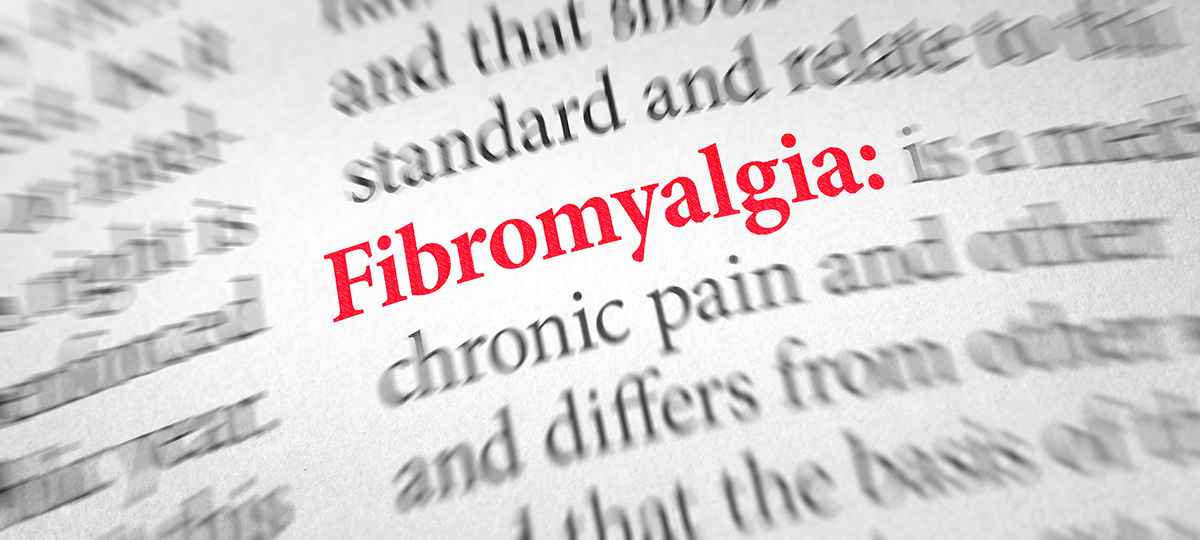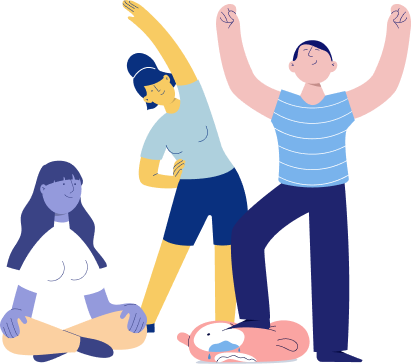What is fibromyalgia?
Fibromyalgia is a chronic disorder which causes widespread pain, along with fatigue and a variety of other symptoms. It is sometimes called fibromyalgia syndrome (FMS). It’s a condition that is not well understood but is being researched more all the time; more answers are coming to the forefront and with them, a better understanding of how to help fibromyalgia patients.
The name fibromyalgia can be broken down. The ‘fibro’ part is the Latin word for fibrosis tissue, which is essentially means tissue that has been damaged or is not reacting in an appropriate way; the ‘myo’ comes from the Greek word for muscle in relation to the widespread muscular pain and the ‘algia’ part of the word, means pain in Greek.
Who can have fibromyalgia?
Anyone can have fibromyalgia, it doesn’t discriminate. It’s a common disorder although there is still stigma around it; between 2% and 4% of the general population are thought to have fibromyalgia as explained by this study.
Fibromyalgia is more common in adults than in children, and is more commonly diagnosed in women; this, however, doesn’t mean that more women actually have fibromyalgia than men. It’s actually thought that the reason more women are diagnosed is due to stigma, meaning that doctors are less likely to diagnose a man who comes to them with widespread pain, and that men are less likely to seek help due to worry about the stigma they may face or the appearance of being ‘weak’. This study tested the prevalence of fibromyalgia in both genders and concluded that, “We found no relevant gender differences in the clinical picture of FMS.”
It does seem that if you had emotional distress, physical or mental trauma in your life, this may trigger fibromyalgia to begin, but this is not yet well understood; this study which found that, “Although there is some evidence supporting an association between trauma and FM, the evidence is not definitive.” From what is known there may be a genetic factor to fibromyalgia, meaning that if someone in your family has it, you may be more likely to develop it, but more research needs to be done into this topic, as explained by this study.
Is it a new disorder?
Since fibromyalgia has recently been more discussed and more awareness is being raised in society in general, a lot of people seem to be under the impression that fibromyalgia is a new disorder. This is not in fact the case, fibromyalgia has a long history.
In fact, as far back as 1800s fibromyalgia symptoms and the relevance of tender points were discovered; it went by different names and various theories were developed over the years, as with many diseases and disorders. In 1904, symptoms that mirror those of fibromyalgia were mentioned; Sir William Gowers presented the diagnosis of ‘fibrositis’, to cover symptoms like pain and fatigue among others. In 1976, the condition got the name fibromyalgia, as explained in this article.
This common misconception that fibromyalgia is a new disorder or a ‘last ditch’ diagnosis is incorrect; this stigma is something that needs to be reduced. Fibromyalgia has been around for years; it is completely valid and entirely real.
What are the symptoms?
The symptoms of fibromyalgia vary greatly, both from person to person, and in an individual. Things like changes in the weather, how active someone is, how much stress they are experiencing physically and emotionally, and how much treatment they have received to cope with their disorder, can all affect the severity of symptoms and the impact on the individual.
- Pain: this pain can be felt all over the body which is why it is defined as widespread; it can be felt in any area at any time and can vary in severity. It also varies in sensation, for example sometimes it may feel like an ache while other times it may be more of a burning, stabbing or pulsing sensation. Sometimes it can feel like all those things at once!
- Fatigue: the fatigue that comes with fibromyalgia can be highly debilitating, sometimes even more so then the pain itself. It can make you feel completely and totally exhausted and can make it tough to function.

- Allodynia: this means that something that should not feel painful, like the feeling of water from the shower on your shoulders, can be translated by your brain and felt as pain.
- Hyperalgesia: fibromyalgia patients are more sensitive to pain, meaning that something that should cause only minimal pain can feel like a severe injury.
- IBS (Irritable Bowel Syndrome): digestive and bowel problems are common in fibromyalgia patients, causing diarrhoea, constipation and other related issues.
- Irritable bladder: as with IBS, bladder problems can be common, meaning that patients may need to go to the toilet more often.
- Problems with sleep: being in pain as well as the other symptoms that come with it, can understandably make it tough to sleep. Even when sleep is possible, it’s often non-restorative, meaning that we don’t feel any benefit from it.
- Problems with temperature control: fibromyalgia can make it difficult to control your temperature, meaning we are often way too cold or experiencing hot flashes.

- Headaches: headaches ranging from mild up to migraines are common.
- Increased period pain: during a menstrual cycle patients with fibromyalgia may experience more painful periods.
- Cognitive problems: problems with thought processing, memory and concentration, also known as ‘fibro fog’ can be highly debilitating.
- Muscle stiffness: muscles that cramp, spasm or become very stiff is common with fibromyalgia.
- Balance problems: issues with dizziness and feeling lightheaded are commonly reported, interestingly so are conditions such as vertigo.
- Paraesthesia: this is more commonly known as pins and needles and can be felt in any area of the body as numbness, tingling, like something crawling on or under your skin among other sensations.
- Restless leg syndrome: feeling unable to keep your legs, or for some patients like me, other areas of your body still, can be distressing.
- Sensitivity to the environment: sensitivity to sound, lights, smells and other environmental factors can cause disorientation.
- Mental health problems: living with a chronic pain condition can be difficult and as a result can often cause mental health problems such as anxiety and depression.
What causes fibromyalgia?
The exact cause of fibromyalgia is still being researched and is not yet known definitively, but it’s essentially understood to be caused by problems in the way that our central nervous system processes pain. Acute pain is a protective mechanism, meaning that pain signals are designed to be sent out when we are experiencing pain, so that we are made aware that there is a danger that we need to address or an injury that needs to be treated. Chronic pain means that the wrong pain signals are being given out, meaning that we are experiencing pain and other symptoms when we shouldn’t be: this is also known as central sensitization.
With fibromyalgia the signals that are supposed to initiate pain are too high and are being sent out too often, while the signals that are supposed to limit pain and ensure that we feel it appropriately, are too low. This study explains that,
Fibromyalgia is now believed to be, at least in part, a disorder of central pain processing that produces heightened responses to painful stimuli (hyperalgesia) and painful responses to non painful stimuli (allodynia).
Medical professionals aren’t sure what starts fibromyalgia, but genetics are thought to play a part and physical or emotional trauma seems to be a trigger for the start of symptoms as explained here.
How severe can fibromyalgia be?
Fibromyalgia is such a varied disorder in that it can vary in severity greatly. For example, an individual can have low pain or even no pain days within which their symptoms are barely noticeable and barely affect their life, all the way up on a sliding scale to severe pain days wherein they feel barely able to get out of bed. Some people may experience their symptoms in such a severe way that they are mostly bedbound, others may find that they are able to be active while using mobility aids and others may function without many issues.
How is it diagnosed?
A fibromyalgia diagnosis is a journey; it takes time and medical professionals will go through a process of tests, eliminating other causes for the pain, and monitoring symptoms. Fibromyalgia symptoms often mirror that of other disorders, so it takes time to rule out alternative causes. Often a doctor will refer patients to a specialist who will ensure that the right diagnosis is given.

In order to be diagnosed with fibromyalgia a patient must have been experiencing widespread pain, on both sides of the body and both below and above the waist, for longer than three months.
Previously during diagnosis an examination of tender points was used, meaning that a doctor would put pressure on eighteen points around the body that a fibromyalgia patient would typically feel pain in to see where you felt pain. This is no longer considered standard practice; while it might still be used as an indicator, it’s no longer thought of as an accurate sign of fibromyalgia as this study explains,
Although the tender point examination has been embedded in the culture of FM diagnosis over the past three decades, it is no longer accepted as a reliable clinical finding and is not included in current diagnostic criteria.
Instead patients are typically assessed using a pain index which divides the body into nineteen sections to assess within which areas of the body the patient is experiencing pain. This is usually combined with what is known as a fibromyalgia questionnaire which addresses the other symptoms and figures out how they severe they are. Combining this with looking at a patient’s clinical history, monitoring them over time and ruling out other causes, a medical professional will then diagnose fibromyalgia.
What is the treatment?
There’s no quick cure for fibromyalgia, it is a chronic condition; but this does not mean that there is no hope! Fibromyalgia can be treated and symptoms can be reduced, functioning can be increased and quality of life in patients can be vastly improved.
Medication might be offered; sometimes painkillers may be prescribed but these tend to be ineffective, thought to be a result of the understood cause of fibromyalgia. Antidepressants are sometimes prescribed which not only help to deal with the emotional impact of fibromyalgia but have also been thought to help with the chemical imbalance causing pain in fibromyalgia patients. Anticonvulsants are sometimes prescribed, thought to calm the overactive pain system. There isn’t a great deal of understanding or research at the moment into how these work, but research is ongoing.
Often medication may focus on symptoms, such as sleeping tablets and muscle relaxants. Massage and acupuncture among other alternative therapies are sometimes used to aid in relaxation. Physical therapy may be offered to help patients strengthen their muscles and learn how to use their body even when in pain.

Self-care is a big part of treating and managing fibromyalgia; this means how patients take care of themselves in their day to day lives. Things like eating healthy meals, exercising, engaging socially, keeping a good sleep routine and keeping active are all beneficial to reducing symptoms.
Other treatments involve talking therapies to deal with the emotional impact of the symptoms, mindfulness techniques, Acceptance and commitment therapy (ACT) to increase functioning and reduce symptoms, and Cognitive behavioural therapy (CBT) to reduce symptoms and improve coping strategies, which has been proven to make a big positive impact on patients with chronic pain and their quality of life.
What is it like to live with?
Fibromyalgia is a tough disorder to live with. I’ve been diagnosed for around five years now and living with the disorder for six years, although I feel that there were signs before that in retrospect. It’s a struggle day to day and it really does alter your life completely; it’s not something that you can ignore or forget about easily. Fibromyalgia tends to affect almost all areas of life and as I have learnt, you must work around it and learn to live with it in order to have a good level of functioning.
When I was first diagnosed I was hit with a mixture of both relief, because I finally knew what was causing my symptoms and despair, knowing that this condition was chronic and it was going to be tough to cope with. At first it was overwhelming, and I found fibromyalgia completely disabling. I was struggling to function; I wasn’t working, I struggled with day to day tasks, I needed a lot of help from my husband and used a mobility scooter to get around.

Once I started to come to terms with my disorder and began to really educate myself about it, to really figure out that pushing myself wasn’t going to damage my body, then my confidence started to grow. I began to use mindfulness and CBT techniques and started to face situations I had been avoiding out of fear that they would cause a flare in my symptoms. Don’t get me wrong it was slow progress and a long journey, one that I am still on, but as I started to increase my functioning and realise that I could function, I really started to regain that quality of life.
One of the things that made the biggest difference for me was exercise; I adored being out with my dogs, and they of course love exercise. Instead of using my mobility scooter, I started to gradually increase my walking. I started from barely being able to walk across the room without agonising pain, but I kept going. I learnt how far I could push myself without aggravating my pain too much, and learnt that even though I was in pain, I could still walk; it wasn’t going to literally ‘hurt’ me. I also learnt that I didn’t need to feel guilty for resting when my symptoms were at their worst.
I started going on real walks with my dogs and my husband. We increased the distances gradually; sometimes I used a walking stick to help me and I took a portable stool to ensure I could rest when I needed to. In the end, being out in nature with my dogs has become my absolute favourite place to me, it relaxes me and although I still experience pain, it’s a lot more manageable now.
Pathways Helps You Break The Pain/Fear Cycle
Enjoy any one of our hundreds of meditations
My functioning has increased, I’m working full time from home and I no longer feel hopeless. Instead, I feel like a warrior. Fibromyalgia has not taken my life from me and it will not, I’m going to keep fighting and continue this journey. The more my symptoms gradually reduce and the more I learn to manage them, the more confident and empowered I feel. Things aren’t perfect and my symptoms are still hard to deal with, but they have improved and now I can function!
Tips I’ve learnt for living with fibromyalgia
From living with fibromyalgia, there are some things I have found that really help me which I wanted to share:
- Gradual and gentle exercise
- Utilize anything that helps increase your mobility
- Release guilt when you need to rest
- Understand that the pain won’t damage you
- Find motivation in things you are passionate about
- Talk about it
I am a huge advocate for exercise;I know that for a lot of people with chronic pain conditions exercise can feel impossible, or even condescending when people suggest that exercise can help. I’m not suggesting that it’s easy or that it’s a quick fix; it has taken me years to get to where I am and I’m still working on it, but it is so incredibly worth it. Take it a step at a time, at your own pace; even small steps forward are still leading you in the right direction.
If mobility aids help you to move your body or to get out and function more, then use them! They can be a great thing and even a stepping stone, like my mobility scooter has been for me. Use walking sticks, stools so you have somewhere to sit, any mobility aid that gets you out of the house and increases your functioning. It isn’t anything to be ashamed of, that’s what they are there for. Using a mobility aid doesn’t mean that you are giving in, it means that you are using everything you can in your fight to be as mobile as possible, and that’s a positive thing.
It’s easy to feel guilty when you need to rest. I found this especially when I was trying to increase my exercising and push myself; I came to realise that it’s about balancing resting when you feel you really need it and pushing yourself when you can.
One of the things that made the biggest difference to my life was truly understanding the cause of my pain, understanding that it’s not going to damage me even if I keep functioning while I’m in pain.
Functioning while in pain is hard, so finding things that you really care about, that you are passionate about succeeding with, makes it worthwhile and can help to keep you moving forward.
Talking about being in pain may seem pointless but sharing any burden with someone you trust can really lighten the weight you are carrying.

- Replace negative thoughts with positive ones
- Face one thing you fear each day
- Make lists
- Find simple joys
I found it helpful when a negative thought came into my head, such as, “you couldn’t complete that walk, you are weak”, to actively say in my head “NO!” and replace that negative thought with a positive one, for example, “you tried hard, look how far you’ve come!”. Don’t let your mind trick you into feeling that you are losing your battle; this isn’t a linear process and bumps in the road don’t mean that you are failing.
When we talk about not avoiding things that we are fearful may increase our pain, we don’t have to do this all at once. Taking it one thing at a time is much more manageable. I try to do one thing each day that I might feel I want to avoid, even if it’s something small like taking a shower even if I feel like I’m too sore to do so. The next day I’ll do the same, and gradually I am building my confidence and beating my fibromyalgia.
Writing down goals that you want to achieve that day to keep you motivated and give you structure, especially if you aren’t working, can be helpful. When you are facing fibro fog it’s also helpful to write things down so that if you forget, it’s there to remind you.
Living with a chronic pain condition can really sap the joy out of your life, it can make you focused on functioning and just surviving rather than thriving. Remember that you are fighting your condition, and you can get that joy back. Do your best to fill your life with small things that really make you happy and take the time in that moment to really appreciate them. Whether this is treating yourself to your favourite dessert, taking a few moments to listen to your favourite song, encouraging yourself to ring a friend or in my case, feeling grounded in nature; it can really improve your quality of life.

- Connect with others who understand
- Use mindfulness and CBT techniques
Feeling that others don’t understand what you are going through can be really isolating, even when you are surrounded by people who love you and want to help. Try to connect with other people who share your diagnosis. You can do this through support groups or online; I’ve found a community of people on twitter who mean the absolute world to me because they really ‘get’ what I am going through.
Practicing mindfulness can really give you that calm and relaxation that you need, it can help you to release your stress. Using CBT can be truly life changing; it can help you to change how you view your condition and reduce your symptoms; whether you implement CBT through your own research like me, see a CBT therapist face to face or use an app like Pathways (update Aug 2023: Pathways is now a web app! Start our program here), the benefits can be significant.
If you are reading this and you are struggling with fibromyalgia or any other chronic pain disorder, please know that you can take your life back; you are strong, and your illness does not control you. You can learn how to control it, how to live with it and beyond it!
Please note: This article is made available for educational purposes only, not to provide personal medical advice.
References
- Dialogues in Clinical Neuroscience, Winfried Häuser, MD.,Mary-Ann Fitzcharles, MD., (2018), “Facts and Myths Pertaining to Fibromyalgia”
- Gender Medicine, Häuser W, Kühn-Becker H, von Wilmoswky H, Settan M, Brähler E, Petzke F., (2011), “Demographic and clinical features of patients with fibromyalgia syndrome of different settings: a gender comparison.”
- The American Journal of Medicine, Volume 122, Issue 12, December 2009, Pages S3-S13, Daniel J.Clauw MD., (2009), “Fibromyalgia: An Overview”
- Arthritis Research & Therapy, Article 218, Dan Buskila, Piercarlo Sarzi-Puttini, (2006), “Biology and therapy of fibromyalgia. Genetic aspects of fibromyalgia syndrome”
- Seminars in Arthritis and Rheumatism, Volume 29, Issue 4, Pages 200-216, MD, PhD, FRCPC Kevin P.White, MD FRCPC SimonCarette, MD, FRCPC ManfredHarth, BSc, MD, FRCPC Robert W.Teasel, (2000), “Trauma and fibromyalgia: Is there an association and what does it mean?”
- Yong-Yeow Chong,MRCP, MMed FAMS, Beng-Yeong Ng, MBBS, MMed, FAMS, (2009) “Clinical Aspects and Management of Fibromyalgia Syndrome “
Pathways Helps You Break The Pain/Fear Cycle
Enjoy any one of our hundreds of meditations












